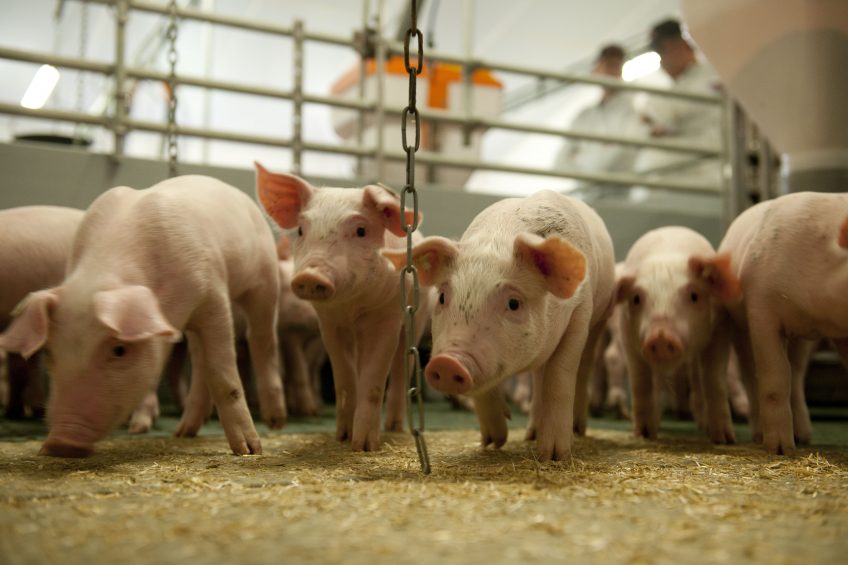Less post-weaning diarrhoea in vaccinated piglets

Most pig farms take preventive measures to limit the economic impact of post-weaning diarrhoea, including safe feed formulations, addition of zinc oxide, use of antibiotics and feed additives. An active prevention through oral vaccination has recently been added to these range of preventive options.
Post-weaning diarrhoea is an important intestinal disease that occurs in the first week after weaning, from days 3-7 post-weaning. The disease is characterised by dehydration, weight loss and death. This form of disease is responsible for economic losses due to death, runt piglets, decreased growth, increased variation in pig sizes within the pen, and increased use, thus increased costs, of medicines. On some pig farms the episode of diarrhoea may be postponed until shortly after the end of zinc oxide supplementation, commonly occurring around 14 days post-weaning.
What is the cause of the disease?
E. coli is the most important pathogen detected as the cause of post-weaning diarrhoea in piglets worldwide. The most important virulence factors are the adhesion factors followed by the enterotoxins. Adhesion factors allow the E. coli bacteria to attach to the intestinal wall, notably through F4 (K88) and F18 adhesion sites. The enterotoxins produced provoke the occurrence of diarrhoea due to disturbance of the electrolyte balance at the level of the intestinal wall. Based on both groups of virulence factors, E. coli associated with post-weaning diarrhoea is also identified as enterotoxigenic E. coli (ETEC). The pathogenesis of post-weaning diarrhoea is schematically shown in Figure 1.
Figure 1 – Pathogenesis of enterotoxigenic E. coli (ETEC) at the level of the small intestine.
A worldwide increase in the occurrence of post-weaning diarrhoea due F4- and F18-ETEC has been reported. A recent study over a 3-year period (2014-2016) on 504 farms in Belgium and the Netherlands has demonstrated that E. coli was the cause of post-weaning diarrhoea in 83.3% of the examined cases, of which were 45.8% F4-ETEC and 37.5% F18-ETEC.
Important for farms
Diseased animals are characterised by pronounced symptoms of fluid faeces (diarrhoea), weight loss, decreased appetite and slower growth, finally resulting in increased size variation of the piglets. The use of current preventive and curative alternatives support the piglets resulting in fewer symptoms of post-weaning diarrhoea.
However, this approach does not always lead to optimal technical performance. Adaptations in feeding strategy using a safe concept – mostly associated with a reduction in crude protein level or energy – results in growth reduction. Addition of zinc oxide provides a temporary protection against growth of E. coli in the intestine, although recent field studies with different feed concepts have demonstrated that optimum growth performance was not achieved using this specific approach.

Also read: Vincent ter Beek’s: Antibiotic confusion
How to diagnose the disease?
The diagnosis of post-weaning diarrhoea can be performed through a combination of typical clinical signs (fluid faeces, runt-piglets, mortality) in relation to the time of the problem relative to weaning. That clinical diagnosis can be confirmed through necropsy and subsequent bacteriological examination. The virulence factors can be detected using a laboratory based PCR-technique.
Figure 2 – Mode of action of the oral vaccination against post-weaning diarrhoea, with reduced clinical signs of diarrhoea and a reduction in faecal E. coli excretion in vaccinated piglets.
Challenges in the near future
Effective preventive measures against this disease are very diverse and remain a challenge for both pig farmers and their advisors. A diverse mix of potential interventions are available through adaptation of feed or addition of specific feed supplements (organic acids, probiotics, prebiotics, etc). Curative treatment with oral antibiotics (through feed or drinking water application) is another frequently used option.
However, the pig world is now encouraged to develop alternatives such as individual treatment through targeted antibiotic injection or herd vaccination to protect against post-weaning diarrhoea. The increasing issue of antibiotic resistance, and the related pressure to decrease their use, suggests that the currently used practices are unacceptable as a long term solution. Zinc oxide is currently still a popular alternative to control colibacillosis in many European countries, although piglets do not perform to their maximum potential using zinc oxide.

Also read: Edgar Garcia Manzanilla looks at: Pig farming beyond zinc oxide and antibiotics
Oral vaccination against post-weaning diarrhoea
The live apathogenic E. coli vaccine*, containing 2 different strains of E. coli, namely F4 and F18, can provide local protection through the stimulation of local antibodies in the small intestine. The vaccine is administered using waterbowls with electrolyte solution including the vaccine, or by individual drenching at least 7 to 8 days before the onset of clinical problems of post-weaning diarrhoea.
Following intake, the live apathogenic E. coli bacteria attach to the intestinal cells and proliferate, thus stimulating local immunity – more specifically the production of immunoglobulin A (IgA) which is secreted into the intestinal lumen – providing the vaccinated animals with local protection.
Within 7 days after vaccination, local protection against subsequent challenge with pathogenic E. coli bacteria during the early post-weaning period is present within vaccinated piglets. The IgA antibodies attach to the fimbriae F4 or F18 from the ingested E. coli bacteria and prevent these pathogenic bacteria from attaching to the intestinal cells and any subsequent proliferation. Preventing this attachment and proliferation causes a reduction in severity of clinical signs, as observed by an improved faecal clinical score and a reduction in the faecal excretion of pathogenic bacteria ensues.
In the long-term, the reduced infection pressure at farm-level results in stable clinical results using the oral E. coli vaccination with consistent reduction in antibiotic use and no need for additional preventive measures, such as inclusion of zinc oxide or other alternatives into the diet. Overall, better performance is seen in vaccinated piglets, offering a clear return-on-investment for the farmer.
References available on request.
* Coliprotec F4/F18, is a registered trademark of PrevTec Microbia, used under license and distributed globally by Elanco Animal Health.














